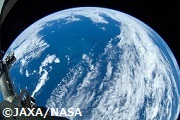| タイトル | A Habitable Fluvio-Lacustrine Environment at Yellowknife Bay, Gale Crater, Mars |
| 本文(外部サイト) | http://hdl.handle.net/2060/20150008374 |
| 著者(英) | Bristow, T. F.; Ming, D.; Farmer, J.; Edgar, L.; Milliken, R.; Gellert, R.; Gupta, S.; DesMarais, D.; Mangold, N.; Arvidson, R.; Hurowitz, J.; Siebach, K.; Meyer, M.; Maurice, S.; Vasavada, A.; Vaniman, D.; Mahaffy, P.; Schieber, J.; Stack, K.; Conrad, P. G.; Blake, D.; Kah, L. C.; Grotzinger, J. P.; Hallet, B.; McLennan, S. M.; Eigenbrode, J.; Beegle, L.; Wilson, S.; Anderson, R. C.; Malin, M.; Crisp, J.; Sumner, D. Y.; Grant, J. A.; Rubin, D.; Lewis, K.; Edgett, K. S.; Calef, F., III; Wiens, R. C. |
| 著者所属(英) | NASA Goddard Space Flight Center |
| 発行日 | 2013-12-09 |
| 言語 | eng |
| 内容記述 | The Curiosity rover discovered fine-grained sedimentary rocks, which are inferred to represent an ancient lake and preserve evidence of an environment that would have been suited to support a martian biosphere founded on chemolithoautotrophy. This aqueous environment was characterized by neutral pH, low salinity, and variable redox states of both iron and sulfur species. Carbon, hydrogen, oxygen, sulfur, nitrogen, and phosphorus were measured directly as key biogenic elements; by inference, phosphorus is assumed to have been available. The environment probably had a minimum duration of hundreds to tens of thousands of years. These results highlight the biological viability of fluvial-lacustrine environments in the post-Noachian history of Mars. |
| NASA分類 | Lunar and Planetary Science and Exploration; Exobiology |
| レポートNO | GSFC-E-DAA-TN21481 |
| 権利 | Copyright, Distribution as joint owner in the copyright |
|

